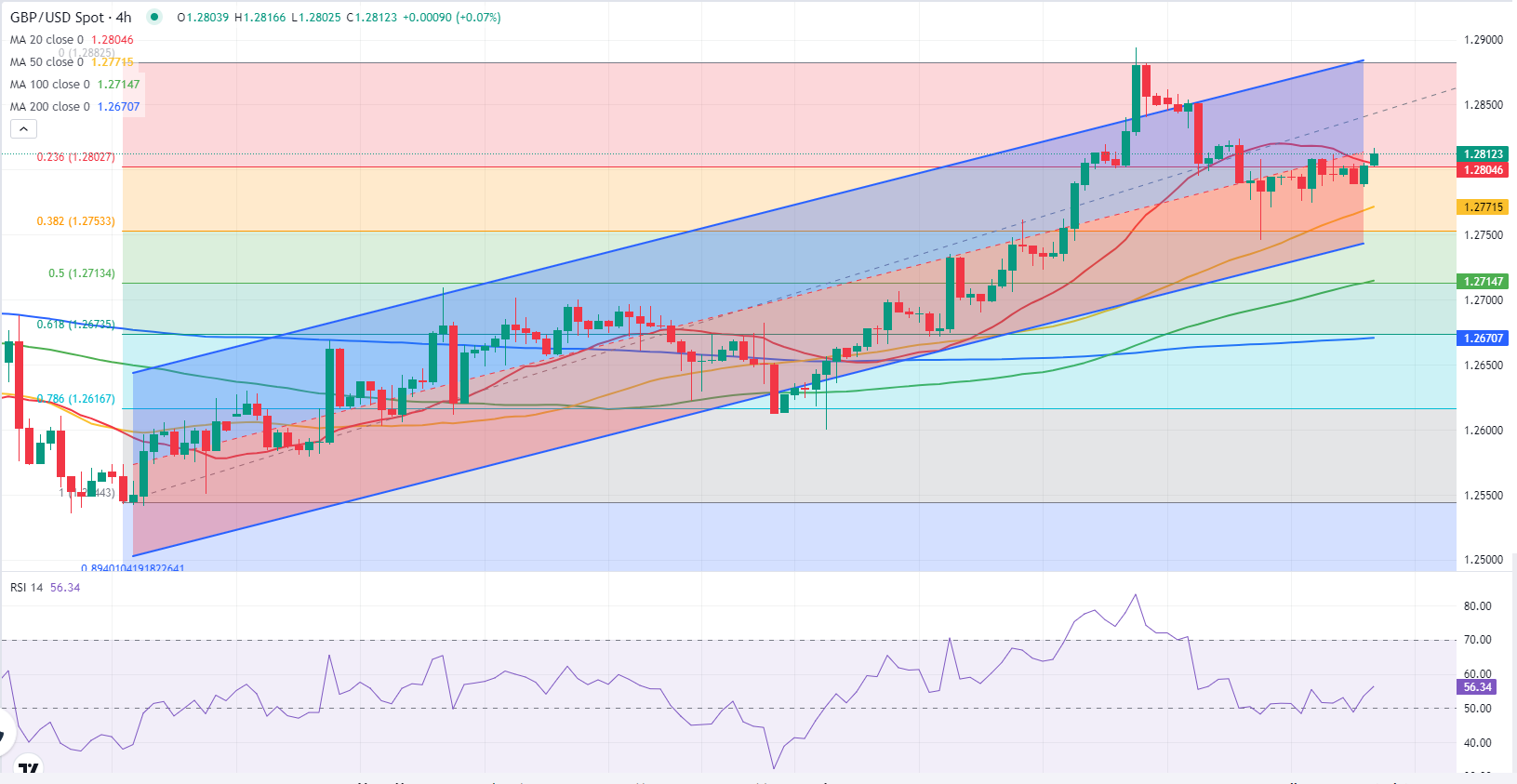- GBP/USD fluctuates above 1.2800 in the European session on Thursday.
- The pair's near-term technical outlook highlights sellers' hesitancy.
- Markets await producer inflation and Retail Sales data from the US.
Following a two-day decline, GBP/USD went into a consolidation phase and closed the day virtually unchanged on Wednesday. The pair holds slightly above 1.2800 in the European session on Thursday ahead of key macroeconomic data releases from the US.
In the absence of fundamental drivers, GBP/USD failed to gather directional momentum midweek. While rising US Treasury bond yields helped the US Dollar (USD) stay resilient against its rivals, the neutral risk mood helped the pair limit its losses.
Pound Sterling price this week
The table below shows the percentage change of Pound Sterling (GBP) against listed major currencies this week. Pound Sterling was the strongest against the Japanese Yen.
| USD | EUR | GBP | CAD | AUD | JPY | NZD | CHF | |
| USD | 0.04% | 0.36% | -0.10% | 0.08% | 0.75% | 0.31% | 0.26% | |
| EUR | -0.04% | 0.32% | -0.15% | 0.03% | 0.71% | 0.28% | 0.22% | |
| GBP | -0.37% | -0.32% | -0.47% | -0.29% | 0.40% | -0.05% | -0.09% | |
| CAD | 0.11% | 0.12% | 0.45% | 0.17% | 0.84% | 0.40% | 0.36% | |
| AUD | -0.08% | -0.04% | 0.28% | -0.19% | 0.68% | 0.24% | 0.17% | |
| JPY | -0.75% | -0.75% | -0.15% | -0.87% | -0.68% | -0.47% | -0.50% | |
| NZD | -0.31% | -0.27% | 0.05% | -0.42% | -0.24% | 0.44% | -0.05% | |
| CHF | -0.27% | -0.23% | 0.10% | -0.37% | -0.19% | 0.47% | 0.04% |
The heat map shows percentage changes of major currencies against each other. The base currency is picked from the left column, while the quote currency is picked from the top row. For example, if you pick the Euro from the left column and move along the horizontal line to the Japanese Yen, the percentage change displayed in the box will represent EUR (base)/JPY (quote).
The US Census Bureau will release Retail Sales data for February later in the session. Investors expect Retail Sales to rise 0.8% following January's 0.8% decline. A print weaker than analysts' estimate could weigh on the USD with the immediate reaction.
Investors will also pay close attention to the Producer Price Index (PPI) figures as well. The Core PPI is forecast to rise 0.2% on a monthly basis, down from the 0.5% increase recorded in January. In case this reading comes in above the market expectation, it could be seen as a USD-positive development.
The US economic docket will also feature the weekly Initial Jobless Claims data. It might be difficult to navigate through the US data releases in the second half of the day. The action in Wall Street and bond markets, however, could help the USD find direction.
GBP/USD Technical Analysis
GBP/USD holds above 1.2800, where the mid-point of the ascending regression channel meets the Fibonacci 23.6% retracement of the latest uptrend and the 20-period Simple Moving Average (SMA) on the 4-hour chart. As long as this level stays intact as support, buyers could remain interested. In this scenario, 1.2850 (static level) and 1.2880 (upper limit of the ascending channel, end-point of the uptrend) could be seen as next bullish targets.
On the downside, first support aligns at 1.2770 (50-period SMA) before 1.2750 (Fibonacci 38.2% retracement) and 1.2730 (lower limit of the ascending channel).
Pound Sterling FAQs
The Pound Sterling (GBP) is the oldest currency in the world (886 AD) and the official currency of the United Kingdom. It is the fourth most traded unit for foreign exchange (FX) in the world, accounting for 12% of all transactions, averaging $630 billion a day, according to 2022 data. Its key trading pairs are GBP/USD, aka ‘Cable’, which accounts for 11% of FX, GBP/JPY, or the ‘Dragon’ as it is known by traders (3%), and EUR/GBP (2%). The Pound Sterling is issued by the Bank of England (BoE).
The single most important factor influencing the value of the Pound Sterling is monetary policy decided by the Bank of England. The BoE bases its decisions on whether it has achieved its primary goal of “price stability” – a steady inflation rate of around 2%. Its primary tool for achieving this is the adjustment of interest rates. When inflation is too high, the BoE will try to rein it in by raising interest rates, making it more expensive for people and businesses to access credit. This is generally positive for GBP, as higher interest rates make the UK a more attractive place for global investors to park their money. When inflation falls too low it is a sign economic growth is slowing. In this scenario, the BoE will consider lowering interest rates to cheapen credit so businesses will borrow more to invest in growth-generating projects.
Data releases gauge the health of the economy and can impact the value of the Pound Sterling. Indicators such as GDP, Manufacturing and Services PMIs, and employment can all influence the direction of the GBP. A strong economy is good for Sterling. Not only does it attract more foreign investment but it may encourage the BoE to put up interest rates, which will directly strengthen GBP. Otherwise, if economic data is weak, the Pound Sterling is likely to fall.
Another significant data release for the Pound Sterling is the Trade Balance. This indicator measures the difference between what a country earns from its exports and what it spends on imports over a given period. If a country produces highly sought-after exports, its currency will benefit purely from the extra demand created from foreign buyers seeking to purchase these goods. Therefore, a positive net Trade Balance strengthens a currency and vice versa for a negative balance.
Information on these pages contains forward-looking statements that involve risks and uncertainties. Markets and instruments profiled on this page are for informational purposes only and should not in any way come across as a recommendation to buy or sell in these assets. You should do your own thorough research before making any investment decisions. FXStreet does not in any way guarantee that this information is free from mistakes, errors, or material misstatements. It also does not guarantee that this information is of a timely nature. Investing in Open Markets involves a great deal of risk, including the loss of all or a portion of your investment, as well as emotional distress. All risks, losses and costs associated with investing, including total loss of principal, are your responsibility. The views and opinions expressed in this article are those of the authors and do not necessarily reflect the official policy or position of FXStreet nor its advertisers. The author will not be held responsible for information that is found at the end of links posted on this page.
If not otherwise explicitly mentioned in the body of the article, at the time of writing, the author has no position in any stock mentioned in this article and no business relationship with any company mentioned. The author has not received compensation for writing this article, other than from FXStreet.
FXStreet and the author do not provide personalized recommendations. The author makes no representations as to the accuracy, completeness, or suitability of this information. FXStreet and the author will not be liable for any errors, omissions or any losses, injuries or damages arising from this information and its display or use. Errors and omissions excepted.
The author and FXStreet are not registered investment advisors and nothing in this article is intended to be investment advice.
Recommended Content
Editors’ Picks

EUR/USD loses momentum to near 1.0300 ahead of Eurozone Retail Sales release
The EUR/USD pair trades in negative territory for the third consecutive day around 1.0310 during the early European session on Thursday. The downbeat German November Factory Orders and the expectation of aggressive rate cuts by the European Central Bank this year weigh on the Euro against the Greenback.

GBP/USD trades near 1.2350 after rebounding from nine-month lows
The GBP/USD pair remains under pressure for the third consecutive session, hovering near 1.2360 during Thursday's Asian trading hours. Technical analysis of the daily chart highlights a prevailing bearish bias, with the pair falling back to the descending channel pattern.

Gold price sticks to modest intraday losses amid bullish USD; downside seems limited
Gold price snaps a two-day winning to a multi-week top amid the Fed’s hawkish stance. Retreating US bond yields undermine the USD and lend some support to the XAU/USD pair. Traders look to Fed speakers for some impetus ahead of the US NFP report on Friday.

Ripple's XRP eyes recovery following executives' dinner with Donald Trump
Ripple's XRP is up 2% on Wednesday following positive sentiments surrounding its CEO Brad Garlinghouse's recent dinner with incoming US President Donald Trump. If the recent recovery sentiment prevails, XRP could stage a breakout above the upper boundary line of a bullish pennant pattern.

Bitcoin edges below $96,000, wiping over leveraged traders
Bitcoin's price continues to edge lower, trading below the $96,000 level on Wednesday after declining more than 5% the previous day. The recent price decline has triggered a wave of liquidations across the crypto market, resulting in $694.11 million in total liquidations in the last 24 hours.

Best Forex Brokers with Low Spreads
VERIFIED Low spreads are crucial for reducing trading costs. Explore top Forex brokers offering competitive spreads and high leverage. Compare options for EUR/USD, GBP/USD, USD/JPY, and Gold.
